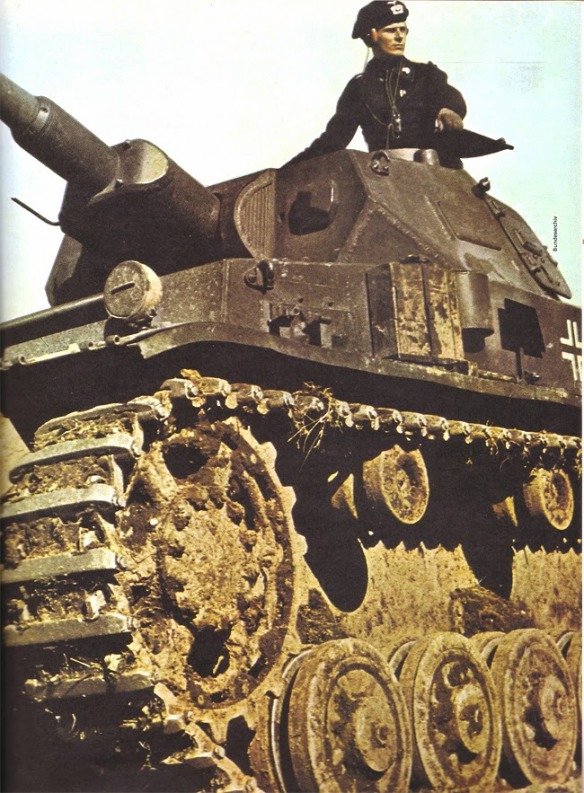It is well known that older, traditional leaders of the German Army initially opposed mechanization and the Panzerwaffe. By the late 1930s, this resistance collapsed in the face of Hitler’s support and the tremendous expansion of the Third Reich which brought in masses of middle-class officers in place of the `aristocrats’. In his classic Misbrauchete Infantrie, General of Infantry Maximillian von Fretter-Pico may have lamented that the panzer troops got the best men, best equipment, high-calorie food and countless other benefits over his long-suffering infantry, fighting and dying for the Fatherland. However, from the start, with their black uniforms and Death’s Head emblems for example, the Panzerwaffe was made to feel special. The rebellious `us versus them’ attitude of early panzer leaders like Guderian seeped `into the souls of the first panzer soldiers’ and later into the entire armor branch.
Training resources were lavished on the panzers. The army created new and expanded panzer schools at Wünsdorf, Bergen, Potsdam, Erlangen and Paderborn and elsewhere, teaching new mechanics, tactics and command and control techniques. With his professional background in training, Guderian took an intense interest in this area. Therefore a highly trained and experienced cadre of panzer leaders carried the Wehrmacht through spectacular early victories, especially in the West and during Barbarossa. Unfortunately for Germany, as happened elsewhere (e. g., Japanese naval aviators in the Pacific), once this core of experts had been attrited and once the enemy recovered from its initial shock and losses, the odds first evened, then turned against it. As history and this book show, by 1943 the Soviets caught up with the invader. A year later we can see that the tide had turned against Germany. Its shrinking manpower pool, now ever more diluted with foreign soldiers less enamored with Nazism, training time in increasing short supply, panzers desperately needed at the front plus fuel and ammunition for training considered a luxury, the relative advantage disappeared.
Operation Barbarossa almost de-mechanized the Wehrmacht, its losses in that campaign were so great. After 1941, the Panzerwaffe lurched from campaign to campaign, rebuilding its strength then losing disastrously, only to repeat the cycle. Tactically, by the middle of the struggle, German and Soviet used many of the same tactics. Here, Red Army numerical superiority and approaching equity in training and quality made themselves felt. During 1943-44, a formulaic dance of action, reaction and counteraction developed, with the usual result being the Germans were pushed back. By 1945, there was no semblance of evenness.
From the very beginnings of Panzerwaffe, divisions were organized as combined arms teams. With the general de-mechanization and dilution of the panzer branch over its ten-year existence, the proportion of actual panzers declined relative to other arms. By the time of Barbarossa, a panzer division had a headquarters, one panzer regiment of two battalions, two motorized infantry/ panzergrenadier regiments (sometimes organized into a brigade) each of two battalions, an artillery regiment plus one battalion each of engineers, reconnaissance, anti-tank, Flak, signal and support troops. Ad hoc Kampfgruppen (battle groups) were common throughout the war, and came in two principal varieties: a combined arms task force created for a particular mission, and as a way to describe a division so reduced that it could not be legitimately counted as a division any longer. In the first case, it was probably named after the senior commander or the commander of the largest sub-unit, e. g., KG Rothenberg, and in the second case it took the name of its former division, e. g., KG 297.
As is the case with most of the world’s armies, formations above division did not have a permanent establishment. Most panzer corps had a headquarters, an artillery command (Arko) to coordinate attached artillery units, signal and support troops. In addition, it might have any combination of anti-tank, engineer, Flak, machine-gun and replacement detachments. Panzer army orders of battle also changed with mission or situation on the ground. The only constant units would be the headquarters, a higher artillery command (Harko – again only to coordinate, with no units of its own) and a signal regiment. Temporary attachments would be artillery, construction, support and training assets.
